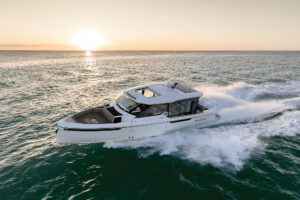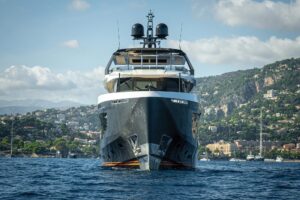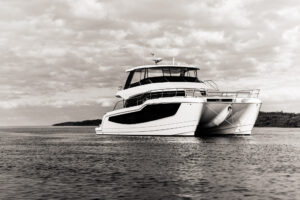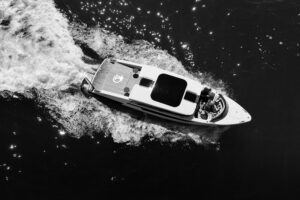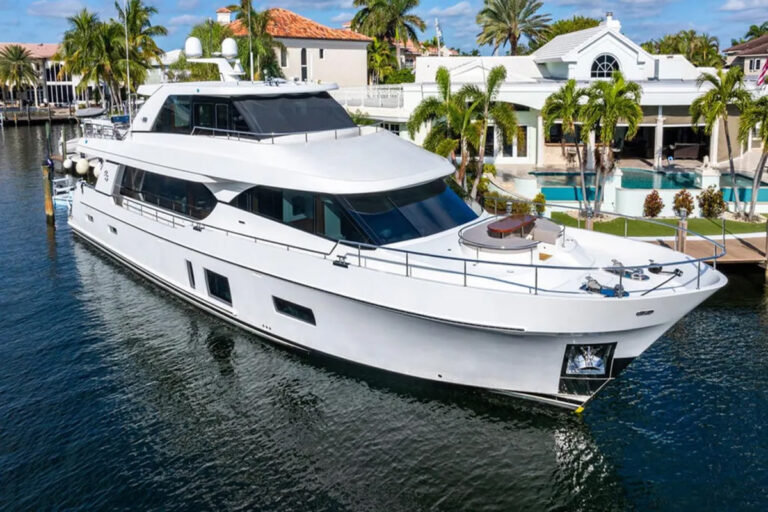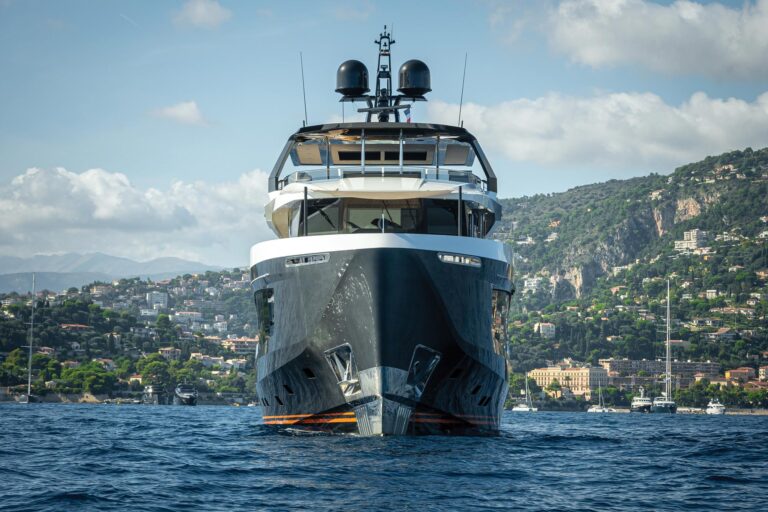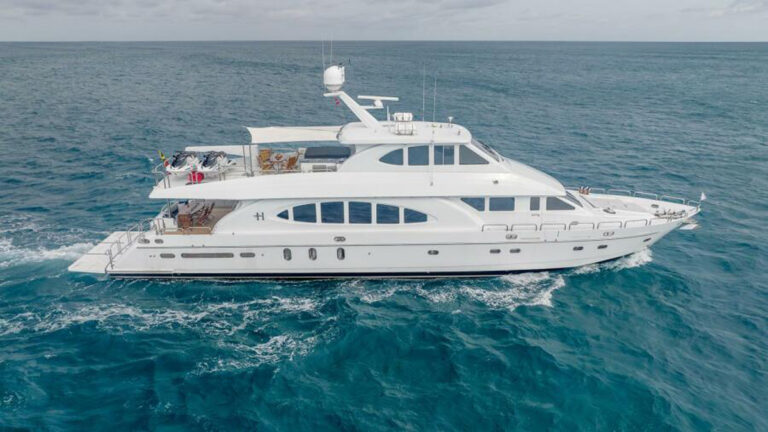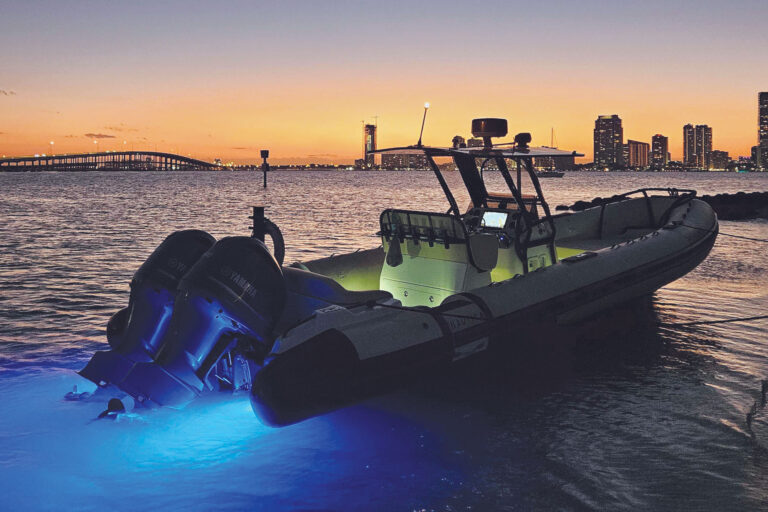A breeze of 15 to 20 knots blew tufts of foam from the wave tops as the 72-foot American Custom Yachts-built Don Teo trolled along at roughly 5.5 knots with just one of her two engines engaged. She rode the seas so easily that only the panoramic view from her enclosed, air-conditioned flying bridge gave any indication we were dragging sailfish baits a mile off Puerto Aventuras, Mexico, instead of idling in a protected harbor.
Though the ride to the fishing grounds was measured in feet, not miles, we still put her through her paces. It was a treat to stand flat-footed and without bracing at 30 knots as we beat into a 4-foot head sea. Increasing the rpm of her twin turbocharged diesels effortlessly leveled the boat, and only by glancing at the GPS could I determine our speed.
Don Teo‘s owner is an experienced yachtsman who wanted to create the “finest sportfisherman currently on the water. He chose American Custom based on the timing of his decision and the production slot that was available. The owner’s confidence in the company, its technical expertise and financial stability, and its proximity to his home also contributed to the decision.
The most important requirement in the owner’s brief was his wish for Don Teo to be self-sufficient, a requirement not usually asked of a sportfisherman. The brief translated into a stunning yacht with above-average stowage capacity, redundant systems and more than standard amenities.
Dawn Moffit Designs handled the interior, and the saloon and galley are an understatement of casual elegance and simplicity, at least from the outside. The bird’s-eye maple joinery shows not a lick of hardware. In fact, hardware is barely visible anywhere on the boat. American Custom Yachts’ execution and attention to details make Don Teo glamorous in her simplicity.
In the saloon, an L-shape settee to starboard has enough dry goods stowage underneath for months of meals. An air handler within the settee diverts conditioned air to the flying bridge deck’s overhang, where vents spill it onto anglers in the cockpit. Ship’s service is to port upon entering the saloon, and twin chairs and a small library fill the space abaft the U-shape dinette, whose settee houses climate-controlled stowage for 12 cases of wine.
In the galley, the Corian counters are elevated to 38 inches to accommodate the owner’s tall frame. Pressing against and opening the cabinet doors reveals sliding shelves with positive latches that secure custom dishes, silverware, cookware, cutlery and glassware. A convection oven is within reach, and an electric stove is out of sight beneath a removable countertop.
Refrigeration and freezer units are custom fabricated of stainless steel and use drawers and shelving. They occupy much of the space below the horseshoe-shape countertop.
Down four steps and to port are the crew quarters. A common head with a granite floor and a large shower joins mirror-image staterooms with upper-and-lower berths. The captain’s quarters abut the utility room, giving him a short trip to the engineroom. The pumps for the twin 1,500 gallon-per-day watermakers are under a hatch in the captain’s stateroom.
The VIP stateroom has a queen berth with stowage beneath. Large cedar lockers and drawers accommodate long-range cruising. Forward of this stateroom’s bulkhead is an anchor compartment that houses a retractable two-piece stainless-steel pulpit. Here, the owner made a concession to the weight-conscious builder and replaced his preferred 300 feet of chain with a mere 24 feet secured to conventional nylon line.
Below the galley is the utility room, which houses most cooling units, each with a dedicated compressor. The forward bulkhead is neatly packed with watermaker manifolds and gauges, and the space holds an upright freezer, a full-size washer and dryer, two watermakers and a water heater-all with room for two adults to move about. Access to the engineroom is via the cockpit or utility room.
The 1,800 hp 16V2000 DDC/MTUs are large, but spaced so a tool cabinet fits between them with a foot of passage on either side. Remote electronic displays monitor the engines’ vitals. A single sea chest handles incoming raw water. Crash valve pumps take over if the bilge pumps are overmatched. Stepped fuel tanks outboard of the engines provide additional mounting areas for compressors. Four additional tanks, two off the keel and two cockpit saddles, hold the balance of the fuel. All fuel is polished and stored in the cockpit tanks before being fed to the engines.
Two 32kW Northern Lights generators supply power when the three 50-amp lines are not providing service. Don Teo can run efficiently on two of three lines. Isolation transformers further secure and protect the electrical systems.
Topside, a bright teak deck and covering boards accent the cockpit, which is so big the Murray Brothers chair is almost lost. The crew uses the fighting chair’s rodholders for trolling the long riggers, so a minimum number of rodholders are embedded in the gunwales. Rupp outriggers spread baits seemingly a block apart, as well as the multiple teasers and dredges, which are retrieved by electric reels concealed in a drop-down hatch in the enclosed bridge’s overhang.
A lazarette opens to rudder and steering mechanics, and a fishbox with an Eskimo ice maker is below the sole. Against the bulkhead from starboard to port are lower station controls, a bait station, a sink and the engineroom door. Underneath are an ice unit, a refrigerator and tackle stowage.
Don Teo‘s top speed during our day aboard was 31-plus knots, a bit slower than normal, according to the crew. A cleaning of the running gear, 3 1/2-inch shafts and four-blade Rola wheels is expected to add a knot or two. Range at cruise is about 600 miles, as the MTUs burn a combined 125 gph.
Visibility forward is wonderful, and the after station on the bridge deck lets the captain keep tabs on the activity in the cockpit. The station high atop the PipeWelders tower makes for easier docking.
The average start-to-finish time at American Custom Yachts is 18 to 24 months. Don Teo took slightly longer, but it was worth the wait to fulfill one man’s dream.
Contact: American Custom Yachts, (561) 221-9100; fax (561) 288-4993; www.americancustomyachts.com.

